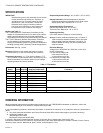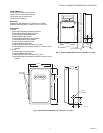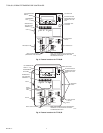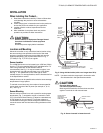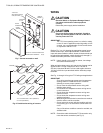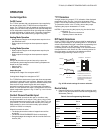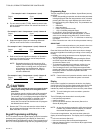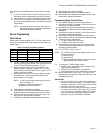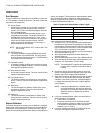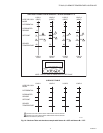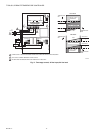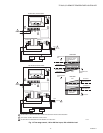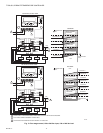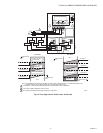
T775A,B,C,D REMOTE TEMPERATURE CONTROLLER
63-2489—2 8
2. For two sensor models (T775B), determine which loads
will be controlled from sensor A or sensor B and enter on
the worksheet.
3. Determine setpoint (Setpt) and switching differential
(Diff) for each load and enter on the worksheet.
4. Refer to the Control Algorithm subsection of Operation
section to calculate the load on and off temperatures.
Enter them on the worksheet.
NOTE: Remember that the on/off outputs are off at
setpoint in both heating and cooling operating
modes. When in cooling mode, the load turns
off at setpoint plus the differential. When in
heating mode, the load turns on at setpoint
minus the differential.
CAUTION
The T775 will not allow the user to program for both
heating and cooling loads to be energized at the
same time.
If this situation results, cooling loads will be energized
and heating loads will be prevented from energizing.
The number (1,2,3,4) of these nonenergized loads will
flash along with the word HEAT to indicate a call for
both heating and cooling loads controlled by one
sensor has occurred and to alert the user to reprogram
the affected control values.
5. Remove the T775 cover and enter the values listed on
the worksheet and the date in the first column on the
label inside the T775 cover.
Keypad Programming and Display
The T775 utilizes a Liquid Crystal Display (LCD) for interactive
prompting during programming and display of sensed and
assigned setpoint and differential values. User programming of
the T775 is accomplished through the four programming keys.
Programming Keys
The four programming keys are Select, Up and Down (arrows),
and Enter:
• Select: Sequentially prompts the user about what parameter
is being displayed. After the last parameter value is viewed,
pressing the Select key again displays the control values
from the beginning of the display loop. The parameters are:
— setpoint,
— differential,
— stage energized,
— heat or cool (operation mode),
— 1,2,3,4 (indicating assigned stage).
• Up and Down: Allow the displayed parameter to be
increased or decreased. After pressing Select, a control
value can be changed using these keys. Control values
increase or decrease by 1°F or 1°C each time an arrow key
is pressed.
• Enter: Places the new value in the microprocessor memory.
IMPORTANT
Control values/operations are not placed in the micro-
processor memory until the Enter key is pressed.
Press the Select and Enter keys at the same time to change
the control algorithm from heating to cooling or from cooling to
heating:
— Heating and cooling parameters are not displayed during
normal Select key sequences.
— The only parameters displayed after pressing the Select
and Enter keys at the same time are the stage indication,
and the word heat or cool.
— To change the operation from heating to cooling (or vice
versa) for a desired output stage, use the arrow keys.
— The next stage of heat or cool assignment appears after
pressing the Select key. When all stages are programmed,
the display reverts to sensed temperature and load
energized status.
NOTE: Control values and operation selection remain in the
device memory even after the power is removed.
Display
Once power is applied or restored to the device, the display
counts down from 210 until the display reads zero. During this
time all previously energized outputs de-energize. This is
intended to protect compressors in the event of a power failure.
NOTE: To avoid viewing the entire countdown, press the
Select key.
The LCD display now shows what it normally reads:
— load (sensed) temperature,
— stages energized,
— and, for two sensor devices, the sensor (Sensor A or
Sensor B) being read.
NOTE: At any time during programming, a 60 second pause
between key presses reverts the display to indicate
the sensed temperature and stage status.
For two sensor applications, the user has three options for
display of sensed temperature. The display can be configured
to:
— lock onto continuous Sensor A,
— lock onto continuous Sensor B sensed temperature,
— alternate between Sensor A and Sensor B (at approximate
five-second intervals).
For example: Load 1: Compressor 1 (cool)
Setpt 1 On at
Diff 1 Off at
For example: Load 1: Compressor 1 (cool)—Sensor A
Setpt 1 On at
Diff 1 Off at
For example: Load 1: Compressor 1 (cool)—Sensor A
Setpt 1 78°F On at
Diff 1 4°F Off at
For example: Load 1: Compressor 1 (cool)—Sensor A
Setpt 1 78°F On at 82°F
Diff 1 4°F Off at 78°F




